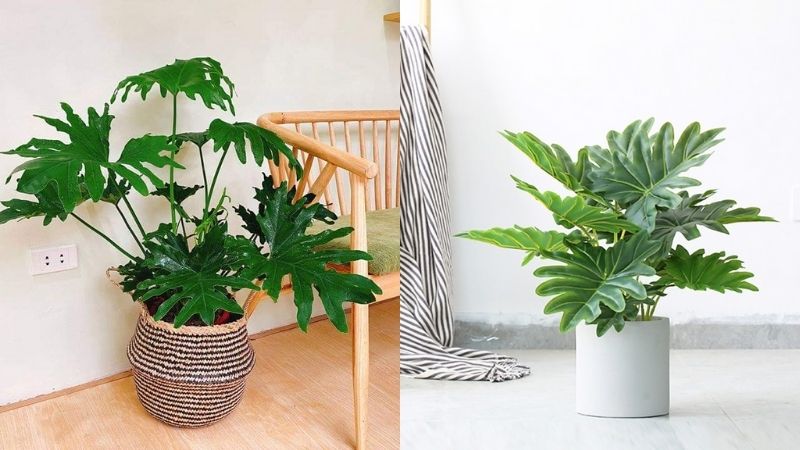The Pothos Epipremnum is an easy-to-grow houseplant, but you may encounter issues with yellowing leaves. Below are some basic guidelines on how to grow and care for your Pothos Epipremnum indoors.
1 Reasons for Pothos Epipremnum Leaves Turning Yellow
 Some reasons for Pothos Epipremnum leaves turning yellow
Some reasons for Pothos Epipremnum leaves turning yellow
If the leaves of your Pothos Epipremnum are turning yellow, it could be due to one of the following reasons:
- Excess Light: Pothos plants do not thrive in excessive light, especially direct sunlight.
- Overwatering: When the plant is waterlogged or sits in water for too long, its leaves will start to yellow.
- Incorrect Fertilization: Both over-fertilization and under-fertilization can cause Pothos leaves to turn yellow.
- Temperature: Pothos prefer cooler temperatures, and extreme heat or cold can lead to leaf yellowing.
- Repotting: When repotted, the plant may experience stress, resulting in yellow leaves.
- Dry Soil: If the soil remains dry for an extended period, the plant will shed its leaves to survive.
- Pests: Insects like mites, aphids, and spider mites can sap moisture from the plant, causing leaves to yellow and wither over time.
- Old Age: Leaf yellowing is a natural process as most leaves turn yellow before they die.
 Direct sunlight is one reason for Pothos Epipremnum leaves to turn yellow
Direct sunlight is one reason for Pothos Epipremnum leaves to turn yellow
2 How to Fix Pothos Epipremnum Leaves Turning Yellow
Water Appropriately
Water your Pothos Epipremnum only when the top layer of soil is dry. When watering, do it slowly and thoroughly. Slow watering allows the roots to absorb water before it drains out completely.
 Water slowly and thoroughly
Water slowly and thoroughly
Use a saucer to catch excess water. Dump out the excess water from the saucer about 30 minutes after watering. By then, the roots will have absorbed the required amount of water. During cold or humid weather, extend the time between waterings.
Moisturize the Plant
Frequently mist or use a humidifier for your Pothos Epipremnum to increase humidity.
 Moisturize the plant regularly
Moisturize the plant regularly
Suitable Light and Temperature
 The ideal temperature range is 59-86°F (15-30°C)
The ideal temperature range is 59-86°F (15-30°C)
Place your Pothos Epipremnum in a bright, indirect light location, away from direct sunlight. The ideal temperature range is 59-86°F (15-30°C), neither too hot nor too cold.
Eliminate Plant Pests
 Eliminate plant pests with soap and water
Eliminate plant pests with soap and water
Mix a mild soap solution (1 part soap to 10 parts water) and spray it evenly on the leaves and stems. Repeat this every 3-5 days until the pests and their eggs are completely eradicated.
Remove Old, Yellowing Leaves
 Removing yellow leaves helps the plant conserve energy
Removing yellow leaves helps the plant conserve energy
Simply cut off the yellow portion of the leaf, or if the condition is severe, remove the entire leaf. Pruning yellow leaves helps the plant conserve energy by not nourishing a damaged part.
Note: Use sharp, clean scissors or pruning shears, and sterilize the tools with alcohol or hot water to prevent infection.
The above information is a compilation of our knowledge about the Pothos Epipremnum plant. We hope it helps you understand and care for your plant better.
Unveiling the Charm of Vietnam’s National Dog Breed: The Phu Quoc Ridgeback
The Móng Cộc is Vietnam’s beloved native dog breed, and rightfully so. This unique canine has a rich history and is an integral part of the country’s cultural heritage. With their loyal nature and distinctive appearance, the Móng Cộc has earned the title of Vietnam’s national dog. In this article, we delve into the fascinating world of these remarkable dogs and explore what makes them such a cherished symbol of Vietnam.
The Ultimate Guide to Raising a Healthy and Happy Dog: A-Z Tips for Puppy Care and Wellbeing
When it comes to raising a healthy and happy dog, it’s natural to want to avoid those niggling health issues that can impact your furry friend’s well-being. Join us as we explore an A-Z guide to dog care, with expert tips to promote your pup’s growth and overall health. Let’s ensure your beloved canine companion thrives!
The Magic of Scented Orchids: A Guide to Cultivating and Caring for These Fragrant Flowers
“Orchid Dendrobium is a stunning and vibrant orchid species with an extensive range of colors. In this article, we will delve into the fascinating world of this exquisite plant and explore its beauty and unique characteristics. Join us on this journey as we uncover the secrets of the enchanting Dendrobium orchid.”




































